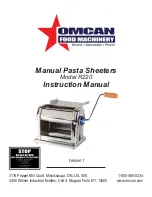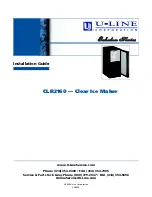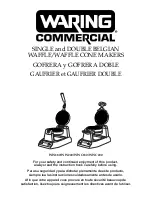
|
79
EN
doors or by removing the control panel.
Remove the nozzles and replace them with suitable
ones according to the BURNERS table. Be careful to
keep and assemble the seal gasket, if any.
Regulation of PEL 21 minimum
(Fig. 3)
Referring to the "BURNERS" table, adjust the
minimum gas flow adjustment screw (B) as follows:
- for LPG operations, tighten the minimum gas
flow adjustment screw up to the stop;
- for operations with natural gas:
1 Find the knob of the corresponding valve.
2 Ignite the burner and bring it to the minimum
position.
3 Adjust the minimum flow rate by turning
the gas flow adjustment screw (B) (Fig. 3):
by unscrewing, the flow rate increases; by
screwing, the flow rate decreases.
4 Once the flame that is considered suitable
for the minimum function has been reached,
check that it corresponds to the minimum
flow rate indicated in the "TECHNICAL DATA"
table; the check must be made according to
the "volumetric method" already described
above, which is:
5 Read the gas meter and, at the same time,
restart the chronometer.
6 After a few minutes, i.e. 10 minutes, stop the
chronometer and read the counter.
7 Calculate the amount of gas which has
passed in 10 minutes (i.e. it’s the difference
between the two readings), for example 2nd
reading - 1st reading = 30 liters (0.03m³).
8 Now calculate the power at the minimum
position, applying the formula of the
volumetric method (see the previous
paragraph). Power (kW) = consumption
(m³/h) x the heating power of methane.
9 If the power is lower than the value given in
the table, unscrew the minimum screw again
and repeat the check.
10 If the power is higher than the value given
in the table, tighten the minimum gas flow
adjustment screw again and repeat the
check. (9.45 kW / h). P (kW) = 30 liters X 60/10
X 9.45 kW / h = 1,700 kW.
Regulation of the pilot light
(Fig. 4)
- The pilot light operates with nozzles and fixed
air. The only requested operation is to replace
the nozzles according to the gas type as follows:
- Loosen the nut, pressing the biconical coupling (N.
14); remove it (N. 15) and the pilot nozzle (N. 16).
- Replace the pilot nozzle with the correct nozzle;
refer to the “BURNERS” table.
connected equipment. Check that the gas supply
pipes are adequate.
Checking the pilot light
When correctly adjusted, the pilot light will
completely surround the thermocouple; if it does
not, check to see if the used injector is suitable for
the type of gas.
Checking primary air
(Fig. 2)
The regulation is made using the Venturi tube by
adjusting the “X” dimension given in the “BURNERS”
table and checking the appearance of the flame
which must be homogeneous, well ventilated and
not noisy.
Checking the functions
- Start the appliance;
- Check the gas pipes for leaks;
- Check the burner flame, even at the minimum
position.
Notes for the installer
- Explain and show how the appliance works to the
user according to the instructions, and hand him
the user’s manual.
- Remind the user that, in the event of any
structural alterations or modifications to the
room that houses the appliance, the appliance
functions must be rechecked.
CHECKING FOR GAS LEAKAGE
After the installation, make sure that there are no
gas leakages. Use some water with soap and brush
it on the joints and fittings; any small leakage will
be shown by means of soap bubbles.
Another way to check for a gas leakage is to make
sure that the meter, if any, over a period of about 10
minutes, does not signal any gas passage.
WARNING: never use an open flame to check for
gas leakages.
RUNNING THE APPLIANCE
ON OTHER TYPES OF GAS
The appliance is tested and set up for operations
with the type of gas given on the technical data
plate. If the gas for which the appliance is regulated
is different from that of the connection, it is
necessary to fit the appliance by carefully following
the instructions below:
Replacement of the burner nozzles
The nozzles are accessible by opening the cabinet
Summary of Contents for 31876500
Page 2: ......
Page 18: ...18 A B 1 3 4 2 5 A 15 14 16 ...
Page 59: ... 59 CPG80E G9CP40 ...
Page 60: ...60 G9CP80 SG9CP40 ...
Page 61: ... 61 SG9CP80 LXG9CP40 ...
Page 62: ...62 SG7CP40M ...
Page 63: ... 63 IT Manuale d istruzioni Dimensioni 64 Dati tecnici 65 Istruzioni specifiche 67 ...
Page 73: ... 73 EN Instruction manual Dimensions 74 Technical data 75 Specific instructions 77 ...
Page 83: ... 83 FR Mode d emploi Dimensions 84 Données techniques 85 Instructions spécifiques 87 ...
Page 94: ...94 DE Bedienungshandbuch Abmessungen 95 Technische Daten 96 Besondere Anleitungen 98 ...
Page 105: ... 105 ES Manual de instrucciones Medidas 106 Datos técnicos 107 Instrucciones específicas 109 ...
Page 125: ... 125 PT Manual de instruções Dimensões 126 Dados técnicos 127 Instruções específicas 129 ...
Page 135: ... 135 EL Εγχειριδιο χρησης Διαστάσεις 136 Τεχνικά χαρακτηριστικά 137 Ειδικές οδηγίες 139 ...
Page 146: ...146 CS Návod k použití Rozměry 147 Technické údaje 148 Zvláštní pokyny 150 ...
Page 156: ...156 SK Návod k použitiu Rozmery 157 Technické údaje 158 Špecifické inštrukcie 160 ...
Page 166: ...166 HU Használati kézikönyv Méretek 167 Műszaki adatok 168 Különleges utasítások 170 ...
Page 176: ...176 DA Brugsanvisning Størrelse 177 Tekniske data 178 Specifikke instruktioner 180 ...
Page 186: ...186 NO Bruksanvisning Dimensjoner 187 Tekniske data 188 Spesifikke instruksjoner 190 ...
Page 196: ...196 SV Bruksanvisning Mått 197 Tekniska data 198 Specifika anvisningar 200 ...
Page 206: ...206 PL Instrukcja użytkownika Wymiary 207 Dane techniczne 208 Szczegółowe instrukcje 210 ...
Page 216: ...216 RO Manual de instrucţiuni Dimensiuni 217 Date tehnice 218 Instrucţiuni specifice 220 ...
Page 237: ... 237 TR Kullanım Kılavuzu Ebatlar 238 Teknik veriler 239 Özel bilgiler 241 ...
Page 256: ...256 AR االستعمال دليل 256 القياسات 255 ية ّ ن الف المعلومات 253 دة ّ د مح تعليمات ...
















































